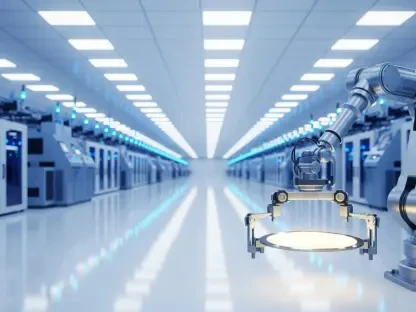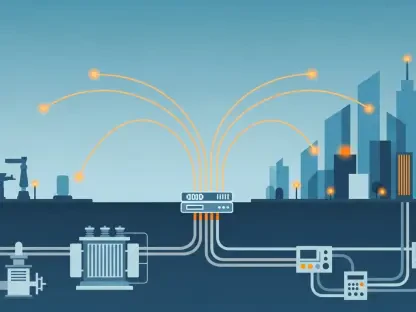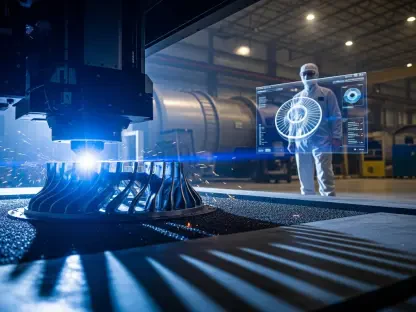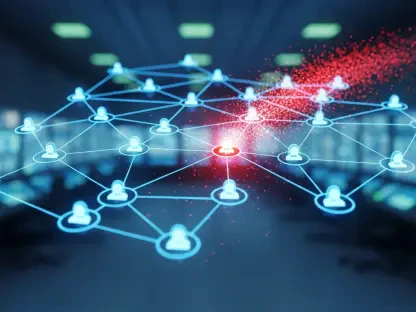The rapid integration of robotics and artificial intelligence into various sectors has brought about a significant transformation in the job market. While this evolution promises enhanced productivity and efficiency, it also poses challenges, particularly concerning job displacement. As machines increasingly manage routine and physically demanding tasks, traditional roles in industries such as logistics, manufacturing, and warehousing are undergoing significant changes. The potential displacement presents an opportunity to redefine workforce roles through strategic reskilling initiatives. With the right approach, robotics developers can play a pivotal role in transforming the looming threat of job loss into an avenue for empowerment and growth.
The Dual Nature of Technological Advancements
Balancing Threats and Opportunities
Technological advancements, notably in robotics and automation, signify both promise and trepidation for the contemporary workforce. On one hand, automation leads to improved efficiency and productivity, streamlining operations in various sectors. On the other hand, it poses an existential threat to jobs that involve repetitive and low-skilled tasks, potentially exacerbating unemployment if not proactively addressed. This juxtaposition of threats and opportunities warrants a revised outlook on technology’s role in shaping the future of work. Rather than viewing automation as a purely disruptive force, industry leaders are slowly recognizing it as a catalyst for transformation. By capitalizing on technological changes, businesses can foster a dynamic workforce ready to adapt and thrive alongside machines.
A crucial aspect of this transformation is addressing potential job displacement with proactive reskilling strategies. Robotics developers, traditionally viewed solely as technology creators, now stand at the forefront as drivers of workforce evolution. By embedding a people-first mindset in their designs, developers can ensure that the technology complements rather than competes with human abilities. This approach redefines automation as a tool for empowering workers, enhancing their capabilities, and creating new, fulfilling job opportunities. Recognizing the dual nature of technological advancements thus involves acknowledging both the challenges posed by job displacement and automation’s potential in fostering a future where machines and humans collaboratively achieve higher productivity and innovation.
Human-Centric Design and Workforce Evolution
In this evolving landscape, adopting a human-centric design approach can be pivotal in reshaping workforce dynamics. Robotics developers need to craft technology solutions that amplify human capabilities instead of merely replacing them. This paradigm shift demands more than just technical expertise; it requires a profound understanding of how individuals interact with machines, ensuring these interactions are intuitive, user-friendly, and conducive to workforce empowerment. Intuitive interfaces, especially, can democratize access to advanced technology, allowing even those with limited technical experience to engage with automated systems efficiently. Furthermore, collaborative robots, or “cobots,” symbolize a forward-thinking integration strategy, promoting a complementary relationship where machines handle monotonous tasks while humans engage in creative, critical, and strategic functions.
Innovative design principles should extend beyond immediate usability to include broader workforce development. By prioritizing inclusivity and accessibility, these systems lower barriers to entry in automated workplaces, facilitating a smoother transition into an increasingly automated world. Successful implementation results in an empowered workforce prepared to navigate new technological interfaces proficiently. Ultimately, placing humans at the center of technological design reflects a strategic approach to workforce evolution, one that embraces the symbiotic relationship between human skills and machine efficiency, paving the path for technological solutions that foster collaboration, adaptability, and growth within the workplace.
Leveraging Technology for Training and Reskilling
Virtual Reality and Augmented Reality in Training
The introduction of cutting-edge immersive technologies such as Virtual Reality (VR) and Augmented Reality (AR) marks a transformative shift in developing effective training solutions. These technologies offer a safe and controlled environment where workers can explore and become proficient in new robotic systems without the risk of disrupting live operations. Through VR and AR, workers can undergo comprehensive simulations that mimic real-world scenarios, enabling them to acquire hands-on experience and develop the skills necessary for managing advanced systems efficiently. This virtual training accelerates skill acquisition, ensuring an adept workforce capable of transitioning seamlessly into new roles necessitated by the rise of automation.
Moreover, immersive training platforms facilitate more than just practical understanding—they foster confidence and adaptability among employees, key attributes for thriving in an innovative, technology-driven environment. These platforms extend beyond simulations to incorporate interactive, scenario-based learning, encouraging creative problem-solving and decision-making—the very skills that are increasingly valuable in an automated workplace. Encouraging ongoing development and engagement through these platforms ensures that employees remain motivated and committed to cultivating their abilities. By prioritizing VR and AR, companies create dynamic learning environments that enhance the effectiveness of reskilling programs, ultimately building a workforce equipped to meet the challenges and opportunities posed by automation head-on.
Redefining Workforce Capabilities Through Technology
Investing in advanced training solutions underscores a broader strategic objective: redefining workforce capabilities to align with evolving technological landscapes. It acknowledges the necessity of shifting focus from mere task execution toward enhancing human strengths, such as creativity, critical analysis, and emotional intelligence. Embracing technological advancements facilitates a transition from rote tasks to more complex, innovative endeavors. The enhanced skills acquired through modern reskilling initiatives position employees as significant contributors to organizational success, enabling businesses to leverage human ingenuity alongside automated processes for superior outcomes.
Innovative training initiatives not only mitigate fears associated with job displacement but also reinforce the agency and value of human workers in automated settings. By investing in reskilling efforts, organizations send a clear message about their commitment to championing workforce empowerment—an attribute that garners goodwill and strengthens company morale. The enhanced capabilities cultivated through technology-driven training programs empower employees with transferable skills, granting them the flexibility and resilience needed to adapt to emerging technologies continually. This forward-thinking approach ensures that organizations can cultivate a robust talent pool poised to drive innovation and competitiveness in a rapidly shifting marketplace characterized by evolving automation and robotics advancements.
Collaborative Efforts for Closing the Skills Gap
Partnerships Between Industry and Education
The endeavor to close the skills gap created by increasing automation necessitates robust collaboration between industry leaders and educational institutions. To establish a workforce proficient in managing and advancing evolving technologies, it is crucial to devise educational curricula and training programs that reflect the competencies required in an automated workspace. By working together, companies and academic bodies can develop specialized certification programs, apprenticeships, and internships that offer prospective employees hands-on experience and understanding of modern robotics and automation systems. Tailor-made educational pathways are essential in equipping students and incumbent workers alike with the practical skills necessary to navigate new roles successfully.
Collaboration extends beyond curriculum development—it involves fostering dynamic learning environments that inspire innovation and creativity. Educational institutions and industries should embrace flexibility, tailoring programs to reflect evolving market trends, technological advancements, and emerging roles within organizations. Providing access to both online and in-person training platforms acknowledges diverse learning preferences and challenges. Establishing a multidimensional, collaborative learning landscape creates pathways for learning opportunities and signals the committed pursuit of continuous innovation essential for equipping the workforce to thrive in a landscape shaped by relentless technological advancements.
The Role of Robotics Companies in Workforce Development
Robotics companies serve as pivotal players in closing the skills gap by taking an active role in workforce development initiatives. As innovators shaping the future of work, these companies hold a unique perspective on necessary competencies and emerging roles. By collaborating with educational bodies to shape relevant, up-to-date curricula, they ensure that training delivers practical, industry-aligned knowledge. Moreover, facilitating engaging settings like workshops and seminars allows these companies to share insights and best practices while drawing valuable feedback from both industry and academic delegates.
Furthermore, robotics companies can engage in mentorship programs, providing students and young professionals with firsthand experience navigating modern technologies and industry challenges. By demonstrating a vested interest in the reskilling process, companies enhance their talent pipeline while contributing to wider industry goals. Initiatives such as these also promote a culture within organizations that values continuous learning and adaptability. In an environment driven by robotics, employees equipped with the latest knowledge and skills can effectively champion innovative solutions, drive competitiveness, and fuel long-term growth. This conscious approach to workforce development enriches organizations and positions robotics companies as leaders in defining a future where technology and people thrive in synergy.
The Business Case for Reskilling Investment
Strategic Advantages of Workforce Transition
Investing in effective workforce transition strategies presents organizations with clear and compelling advantages in adopting new technologies. As businesses embrace automation to remain competitive, prioritizing employee education and development becomes increasingly strategic. Companies that place emphasis on reskilling benefit from smoother adoption cycles, minimizing potential disruptions or resistance typically associated with misconceptions surrounding job displacement. A well-prepared workforce, equipped with the necessary skills and awareness, is better positioned to seamlessly integrate new processes and technologies.
Moreover, empowered employees equipped with confidence in their roles are more likely to experience heightened job satisfaction, fostering increased productivity and reduced turnover. Retaining skilled personnel reduces recruitment and retraining costs while sustaining organizational continuity. By positioning employees as integral contributors within automated settings, businesses can enhance team cohesion, collaboration, and innovative outcomes. Additionally, organizations committed to reskilling align themselves with a more ethical and socially responsible image, attracting customers, partners, and stakeholders supportive of such progressive values. This strategic realignment positions these companies as market leaders embracing technological advances while maintaining genuine care for their workforce and stakeholders.
Building a Social License and Customer Trust
Organizations that demonstrate genuine care and commitment toward workforce development and empowerment stand to benefit from increased customer trust and loyalty. In ever-scrutinized consumer landscapes, businesses earning ethical and socially responsible reputations garner goodwill and engagement from conscientious customers. Investing in the workforce reflects a broader commitment to enhancing the societal fabric, a value increasingly prioritized by consumers, investors, and regulatory bodies alike. Organizations leading through authentic and transparent actions can solidify a social license to operate, attracting customer bases seeking to align themselves with responsible corporate citizens.
The strategic advantage of investing in workforce reskilling extends beyond consumer relations to significantly influence partner engagements and stakeholder interests. Corporations that view workforce education as a long-term investment signal reliability, resilience, and adaptability—qualities essential for forming sustainable industry relationships. Ultimately, building a social license through reskilling reinforces the interconnection between technological evolution and its impact on society. As robotic technology revolutionizes workplaces, companies that embrace this transformative opportunity holistically embody leadership and values essential for shaping an equitable, proficient future that benefits all participants equitably.
Envisioning a Collaborative Future in Automation
Paving the Path for Workforce and Robotics Integration
The landscape of modern work necessitates reimagining and redefining the interplay between human abilities and automation technologies. Efforts to foster collaborative synergy focus on harmonizing the coexistence of skilled personnel and intelligent machines. Robotics developers, alongside industry leaders, are tasked with strategically weaving human ingenuity into automated processes, creating an innovative framework where machines and workers collectively amplify productivity. Prioritizing collaboration leads to complementary dynamics, where each entity leverages its strengths—technology in precision and speed, and humans in creativity, empathy, and strategic thinking—for superior outcomes.
Integral to this mutualistic future is the collaborative development of intuitive tools and platforms that empower individuals to harness technology effectively. Viewing machines as enhancers of human capability is essential to reimagining workplace culture around collective achievement. As automation introduces new demands and complexities, it concurrently allows for innovations that propel humanity beyond routine tasks, focusing on pursuits fostering higher creativity, strategic insights, and improved societal contributions. Essential are efforts nurturing this balance, ensuring that advancements support shared growth and serve meaningfully, transforming society’s broader technological collaboration aspirations.
A Shared Vision for an Inclusive Workforce Evolution
Realizing a harmonious integration of technology and the workforce means embracing a shared vision that values inclusivity, adaptability, and empowerment. This vision requires recognizing automation as a tool for collective progress, providing individuals with genuine opportunities for personal development, fulfillment, and career advancement. Engaging organizations, institutions, and stakeholders in dialogue fosters an environment supporting sustainable economic growth while addressing inequalities and barriers faced by marginalized workforce segments.
Efforts toward inclusivity entail not only accessibility to new roles and technologies but also proactively creating pathways for those at risk of exclusion within automation-driven frameworks. Community involvement and strategic partnerships can play instrumental roles in reinforcing this mission, crafting dedicated initiatives that ensure equitable participation and representation across varied industries influenced by technological transformations. Championing an inclusive approach to workplace evolution generates meaningful results that integrate economic interests with ethical values, forming resilient, innovative communities capable of thriving in an automated future.
Transforming Challenges into Opportunities
Championing Workforce Empowerment
Embracing reskilling opportunities in robotics and automation technologies beckons organizations to be champions of workforce empowerment. By fostering environments where human potential and mechanical precision synergistically coexist, companies catalyze broader transformation and social evolution. Investing in education-driven initiatives and technological advancements embarks on pathways that minimize displacement’s adverse impacts while amplifying human capabilities throughout the workplace ecosystem. This effort heralds a paradigm focused on mutual growth, innovative disruptions, and social equity.
Robotics developers and industry leaders must prioritize thoughtful collaboration, weaving human-centric solutions into technology design and driving creative negotiations between employee skill sets and mechanical proficiency. Partnering education institutions and corporations under shared objectives reinforces employee confidence, positioning them as valuable contributors to automated and innovative workplaces. Empowerment cascades beyond individual roles, establishing forward-thinking communities that challenge disparities, hinder automation, and equitably benefit from its transformative potential.
Future-Forward Innovation at the Heart of Progress
The pinnacle of progress lies in framing innovation and workforce empowerment as integral components of collectively responsible actions. By embracing automated technologies, organizations have a unique opportunity to lead industry standards. They can exemplify progressive engagement that respects workers while pioneering robotics. Commitment to reskilling, ethical development, and societal integration secures aspects that benefit both present-day actors and those paving paths for future generations.
Future-forward initiatives foster sustainable practices aimed at harmonious coexistence with technological advancements, emphasizing tailored roles that augment humanity’s most distinct strengths. Collectively envisioning a future where humans thrive alongside automation signifies not only a commitment to technological innovation but also an understanding of its capacity to elevate societal well-being. As these commitments intertwine, they sculpt the essence of meaningful progress characterized by resilience, creativity, and a shared purpose that ensures everyone in society benefits from technological advancement, creating lasting legacies for future generations in robot-assisted economies.
Charting the Path Ahead for Workforce Reskilling
The swift integration of robotics and artificial intelligence (AI) within various sectors has significantly reshaped the job market landscape. This evolution promises enhanced productivity and increased efficiency, yet it presents challenges, especially regarding job displacement and shifts in employment patterns. As machines increasingly handle routine and physically demanding tasks, traditional roles in industries like logistics, manufacturing, and warehousing face substantial changes. While such potential displacement may appear daunting, it also represents an opportunity to redefine workforce roles. Through strategic reskilling initiatives, there is a chance to equip the workforce with new skills better suited to the emerging technological landscape. With a proactive approach, developers of robotics and AI technologies can play a crucial role in transforming the threat of job displacement into an opportunity for growth and empowerment. By embracing this change, the workforce can adapt and thrive, turning potential challenges into avenues for innovative roles and career development.









